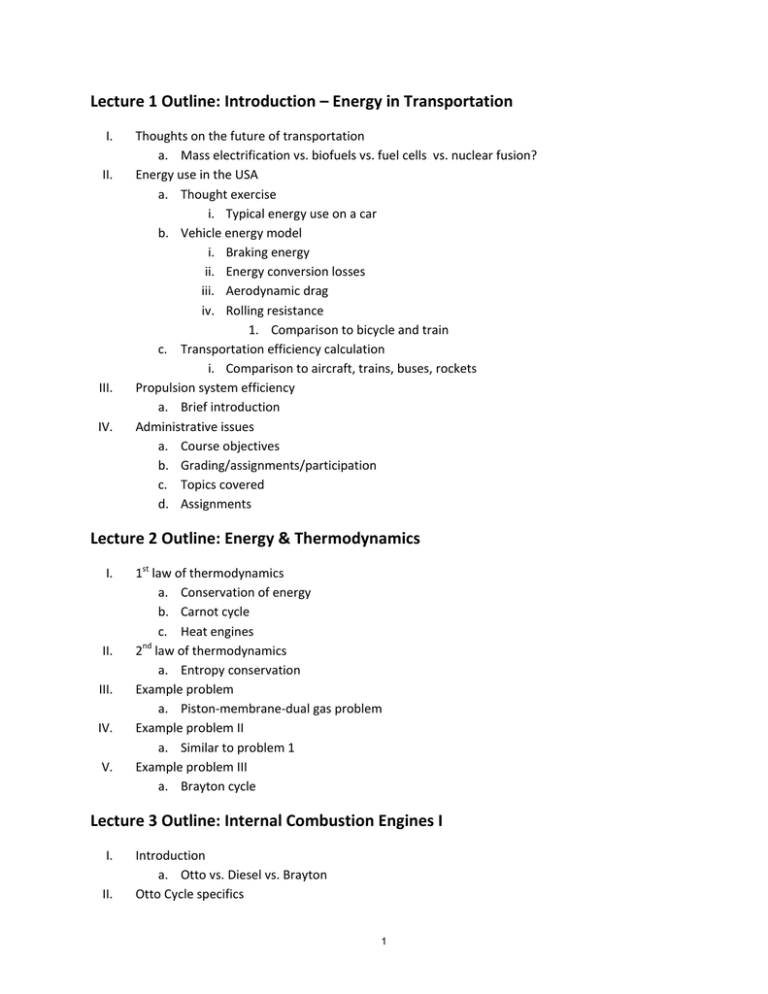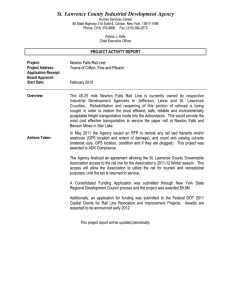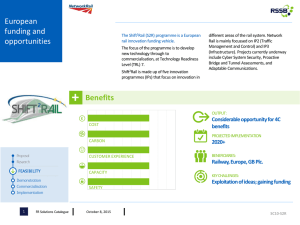Lecture 1 Outline: Introduction – Energy in Transportation
advertisement

Lecture 1 Outline: Introduction – Energy in Transportation I. II. III. IV. Thoughts on the future of transportation a. Mass electrification vs. biofuels vs. fuel cells vs. nuclear fusion? Energy use in the USA a. Thought exercise i. Typical energy use on a car b. Vehicle energy model i. Braking energy ii. Energy conversion losses iii. Aerodynamic drag iv. Rolling resistance 1. Comparison to bicycle and train c. Transportation efficiency calculation i. Comparison to aircraft, trains, buses, rockets Propulsion system efficiency a. Brief introduction Administrative issues a. Course objectives b. Grading/assignments/participation c. Topics covered d. Assignments Lecture 2 Outline: Energy & Thermodynamics I. II. III. IV. V. 1st law of thermodynamics a. Conservation of energy b. Carnot cycle c. Heat engines nd 2 law of thermodynamics a. Entropy conservation Example problem a. Piston-membrane-dual gas problem Example problem II a. Similar to problem 1 Example problem III a. Brayton cycle Lecture 3 Outline: Internal Combustion Engines I I. II. Introduction a. Otto vs. Diesel vs. Brayton Otto Cycle specifics 1 III. IV. V. VI. VII. VIII. a. Animation b. PV diagram c. Comparison to ideal Carnot efficiency Diesel Cycle specifics a. Animation b. PV diagram c. Comparison to ideal Carnot efficiency Otto vs. Diesel a. Key differences i. Mechanical components ii. Efficiencies Brayton Cycle specifics a. Animation b. PV diagram c. Comparison to ideal Carnot efficiency Engine Applications: Gasoline a. Light vehicles and machinery Engine Applications: Diesel a. Heavy machinery Engine Applications: Brayton a. Aircraft b. Stationary power generation c. Some heavy machinery Lecture 4 Outline: Internal Combustion Engines II I. II. Piston engines a. 2 stroke vs. 4-stroke b. Improvements i. Turbo and super-charging ii. Direct Injection 1. HCCI iii. Variable valve timing c. Emissions i. Emissions types ii. On-board vehicle controls 1. Catalytic converters 2. Particulate traps 3. Gasoline vs. Diesel differences iii. Government regulations Vehicle improvements a. Transmissions 2 III. i. Introduction to DSG, CVT, 7 and 8 speed automatics b. Start/stop Transition to hybrid/electric drivetrains Lecture 5 Outline: Road Vehicle Engineering & Components I (Vehicle Dynamics, Powertrain & Components) I. II. Model for vehicle power demand a. Thermodynamic efficiency b. Vehicle Mass c. Aerodynamic drag d. Rolling Resistance Vehicle Dynamics a. Geometry i. Wheelbase and track width ii. Steering and suspension angles b. Mass Distribution i. Roll Centers c. Traction i. Center of traction d. Aerodynamics i. Center of pressure e. Vehicle Response i. Under/Oversteer ii. Weight transfer iii. Speed wobble f. Advanced control Lecture 6 Outline: Road Vehicle Engineering & Components II III. IV. V. Powertrain components a. Manual transmission b. Automatic transmission c. CVT Materials a. Steel b. Aluminum c. Magnesium d. Composites Manufacturing processes a. Stamping b. Welding 3 VI. Electronics / Communication a. CANbus Lecture 7 Outline: Electric & Hybrid Vehicles I (Consumer Electric Vehicles) I. II. III. IV. V. Brief background a. Different types of electric vehicles i. Commercial applications, etc… b. History of the development of the electric car i. 1968 Great Electric Car Race c. “Who killed the electric car” – brief mention Drivetrain comparison a. Conventional vs. Hybrid vs. Battery-Electric b. Efficiency comparison Technical – efficiency ratings a. Terminology Benefits a. V2G possibility b. Night-time charging New energy sources a. Power grid capacity b. Operating costs c. CO2 emissions Lec 8 Outline: Electric & Hybrid Vehicles II VI. VII. Challenges a. Energy density b. Range c. Charge time d. Cost e. Battery life f. Consumer acceptance g. Operating cost EV research at MIT Lecture 9 Outline: Rail Transport: Fossil Fuel, Electric, Urban & High-Speed (Fossil Fuel Rail) I. II. Rail Transportation Overview Technical Overview of Rail and Energy a. Aerodynamic Drag b. Hertz contact forces 4 III. IV. V. VI. VII. c. Energy balance vs. automotive Rail Operations a. Switches b. Track Gauge c. Study of train wear, standards or gauges Steam Engine History a. Pre steam engine rail b. Development of Steam Engine, James Watt (1794) c. 1830, first intercity rail opened (Liverpool – Manchester) d. 1869, first transcontinental railway completed in US e. Steam dominant in rail from early 1800’s till about 1930 Steam Engine Components a. Boiler b. Steam Circuit c. Running Gear d. Couplings Steam Engine Fuel a. Wood (US early), Coal b. Water Dieselisation a. Compression ignition patented by Dr. Rudolf Diesel in 1892 b. Advantages over steam i. Much less pollution / cleaner work environment ii. Can be operated by one engineer iii. Higher thermodynamic efficiency iv. High tractive load c. Diesel Cycle d. Mechanical Transmissions i. Usually fluid coupling between engine and epicyclic gearbox ii. Transmission can be limiting factor for power and torque output Lecture 10 Outline: Rail Transport: Fossil Fuel, Electric, Urban & High-Speed (Electric Rail) VIII. Diesel – Electric a. Classifications i. On-board generation (hybrid diesel electric, gas turbine) ii. On-board storage (battery electric) iii. Off-board generation (third rail, overhead lines) b. Currently almost all locomotives are diesel-electric c. Technical i. Diesel engine to electric generator to electric traction motors 5 IX. ii. (power transmission) - DC Versions until 1960’s iii. AC made possible by high capacity silicon-carbide rectifiers d. Throttling i. Usually accomplished in discrete steps Electric Rail a. Patent by Thomas Edison b. Late 19th century c. Advantages i. >90% efficiency of traction motors ii. Less pollution iii. Efficiency gains from regenerative braking d. DC vs AC i. Allowable voltage ranges ii. Regenerative braking / fail safe motor braking iii. Transition from DC to AC iv. Grids Lecture 11 Outline: Rail Transport: Fossil Fuel, Electric, Urban & High-Speed (Urban & High Speed Rail) X. XI. Urban Rail a. History b. Presence in cities i. United States ii. World c. Technologies i. From coal / steam to electric early on Intercity / High Speed Rail a. History i. Japan – Shinkansen ii. Europe iii. China iv. United States b. Technology i. High Speed ii. Aerodynamics iii. Safety c. Mag Lev Trains 6 Lecture 12 Outline: Water Transport: History, Vessels, Port Operations (Water Transport History) I. II. III. Energy efficiency: a. BTU per ton-mile: i. Rail: 341 ii. Water: 510 iii. Heavy Trucks: 3,357 iv. Air freight: 9,600 Most are propelled by diesel a. 2-stroke turbo i. Largest run on heavy fuel oil (little distillation required) b. Nuclear is insignificant i. A few experiments in the ‘60’s; Russia has a few nuclear ice-breakers, not much else c. Single engine, single-screw is generally preferred i. Reliability and economy 3-year engine overhaul schedule Lecture 13 Outline: Water Transport: History, Vessels, Port Operations (Water Transport: Vessels) I. II. III. IV. V. VI. VII. VIII. IX. 7.4 billion tons of cargo carried in 2007, globally (Source: wiki) a. Vs. Bulk Passenger Tanker a. Oil b. LPG c. Chemicals d. Food Reefer ships a. Temperature controlled RORO (roll on / roll off) ships a. Ferries, for automobiles, etc… Cruise ships a. Many have propulsion by azimuth thrusters – large electric motors in pods b. Diesel-electric i. Electrical losses: ~8% 1. Vs. shaft/mechanical losses at 2% Improvements currently considered: counter-rotating propellers at pods Energy use per item carried 7 X. a. Also per ton Compared to other transportation methods Lecture 14 Outline: Water Transport: History, Vessels, Port Operations (Port Operations) I. II. III. IV. Containerization a. TEU – twenty foot equivalent unit, 20*8.0*8.5 feet b. Most today are 40-foot containers (2 TEU containers) c. Since 1960’s – containerization (also interface with rail and road) Big organizational hurdle: a. Movement: i. Ships ii. Containers iii. Cargo b. Loading/unloading c. Smaller ships – tugs d. Storage – warehousese e. Cashflow + pricing f. Information management g. Customs h. Marketing and competition i. Safety+security j. Environment and sustainability Example from 15.053 – operational research algorithms a. Maximum flows i. Math problems Stats: a. Port flows Lecture 17 Outline: Aircraft Types I. II. Intro to Chapter 1 - History a. Balloons/Dirigibles b. Heavier than air c. Commercial Air transport d. Helicopters e. Conquest of space f. Commercial use of space Current uses of aircraft a. Manufacturers overview i. Equipment volume / market share 8 III. IV. V. b. Transportation efficiency per given payload Airport considerations a. Traffic and logistics i. Relationship to port operations Fuels a. Sources/volume b. Future possibilities c. Consumption increase / industry growth Maintenance Intervals Lectures 18 & 19 Outlines: Fixed-Wing Aircraft Aerodynamics I & II I. II. III. IV. Lift: a. Buoyancy lift b. Lift from fluid air motion Sources of Drag: a. Profile Drag b. Induced Drag c. Effects on Drag 2-D Aircraft model a. Equations of motion Steady Flight: a. Thrust-velocity curves b. The stalling speed of an aircraft c. Maximum lift-to-drag ratio d. Endurance and range of an aircraft e. Gliding flight f. Technical: i. Basic equations governing flight – applied with examples relating to different aircraft geometry g. How Helicopters Work Lectures 20 Outline: Aircraft Engines Goal: Understand the principles that guide their design for varying applications. Basic combustion process has already been covered). I. II. III. IV. V. VI. Inlet Compressor Combustor Power Turbine Nozzles Engine Types 9 a. b. c. d. e. f. Turbojet Turbofan Turboprop Afterburning turbojets Ramjets Ultra high bypass engines / Future possibilities Lectures 21 Outline: Helicopters I. II. III. IV. V. Basic mechanics a. Swashplate + blade pitch control b. Physics behind tail rotor and twin rotor helicopters Power plants Efficiencies – quick overview: homework problem Uses Role in transportation Lectures 22 Outline: Radar I. II. III. IV. History Principle of operation Configurations and types Role in transportation today Lecture 24 Outline: Navigation Module (Navigation) I. History a. Improvements leading up to the GPS era i. Celestial navigation ii. Original mapping techniques 1. Compass invention iii. Piloting iv. Dead reckoning Lecture 25 Outline: Navigation module (Global Positioning System GPS) I. GPS History a. LORAN and Decca Navigator – WWII ground based nav b. Observation of Doppler effect on Sputnik (1957) c. First satellite nav system – Transit, US Navy, 1960 d. GPS developed in response to nuclear age – SLBM fixing, etc e. 1973 – Navstar GPS program created, combining multiple military projects f. Pres Reagan made GPS available for civilians after 1983 Korean Air disaster 10 II. III. IV. g. Satellites launched between 1989 and 1994 h. Pres Clinton disables selective availability in 2000 GPS Technology Basics a. System Architecture i. DOD operated ii. Space Segment 1. 24 to 32 satellites in medium earth orbit (~20000 km) 2. 6 planes of 4 satellites each 3. >= 6 satellites always within line of sight from anywhere on earth iii. Control Segment – master control station and monitor stations iv. User segment – military and civilian users of GPS v. Atomic clocks, corrections for relativity b. Competition to GPS i. EU, China, Russia c. Message Transmission i. Time of Message ii. Precise Orbital Information (Ephemeris) iii. Almanac of all GPS satellites d. Position and Velocity Calculation i. Trilateration using propagation time of signal ii. Usually requires at least 4 satellites iii. Time delays create sphere’s of possible location from each satellite. Intersection of spheres indicates position e. Accuracy i. After SA disabled, civilian accuracy improved from 300 meters to 20 meters ii. Receiver clock major source of error Possibilities and Limitations GPS Applications a. Navigation, Map Making, Surveying b. Integration with cellular telephony c. Geofencing d. Geotagging e. Missile and projectile guidance f. Reconnaissance, Search and Rescue g. GPS Satellites – US Nuclear Detonation Detection System Lecture 26 Outline: Navigation Module (Global Information System GIS) V. GIS Overview a. Definition (data linked to locations) b. History i. 1854 John Snow – Cholera outbreak 11 VI. VII. VIII. IX. X. XI. XII. ii. 1960’s – computer mapping applications for nukes iii. Roger Tomlinson – father of GIS – Canada GIS iv. 1980’s/1990’s – consolidation of available platforms GIS Data Representation a. Spatio-temporal location is key index variable b. Two Abstractions i. Discrete Data (houses, etc) ii. Continuous Data (rainfall, elevations, etc) c. Raster Images d. Vectors e. Image processing, raster to vector translation f. Point Clouds (3D points with RGB information) Data Capture a. Digitizing Map and Survey Data b. Photography c. Satellite remote sensing d. Processing, error removal Geocoding Reverse Geocoding Advantages / Disadvantages a. Uncertainties come when combining data from many different sources b. Quick analysis and representation of complex data sets c. Visualization of nonhomogenous entities d. Crazy consumer apps Open Geospatial Consortium (OGC) Standards a. 384 companies, agencies, etc b. OpenGIS Specifications => geo-enable web apps, enable use of complex spatial information GIS Applications a. Web Maps (Google Maps, etc) b. Business planning (store locations, etc) c. Monitoring Climate Change (Polar ice caps – map overlay) d. Hydrological Modeling e. Automated Cartography f. Geostatistics Lecture 27 Outline: Navigation Module (Modern Mapping Techniques) I. II. History of cartography Satellite ownage. 12 MIT OpenCourseWare http://ocw.mit.edu 16.682 Technology in Transportation Spring 2011 For information about citing these materials or our Terms of Use, visit: http://ocw.mit.edu/terms. 13




